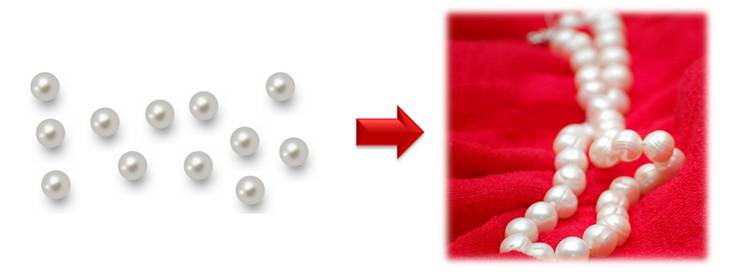Home > Presentation Outline >Presentation Structure
This article provides 6 different types of presentation structure you can use to create stronger outline for your presentations.
As a presenter, you may feel that you have great points to share. But, these points won’t be remembered and appreciated till you get the structure of your presentation right .
Like the way a simple string connects a set of pearls…

The science behind using a logical presentation structureA study by George A Miller, a Harvard Psychologist, suggests that human beings can understand and remember no more than seven plus or minus two items of information at a time. This phenomenon is called the “chunking limit”. More importantly, as information gets more complex, this chunking limit decreases. |
How does this study affect us, as presenters?
A good presentation structure has the power to break down a large and complex idea into short meaningful chunks and connect them into a memorable story.
What are the different ways to chunk information?
Once you have defined your presentation objectives you can think about the structure of presentation detailed below.
You can chunk any complex information using 6 basic questions:
Who, What, When, Where, Why and How.
Here is how you treat each presentation structure…
In the first one, we will use two questions together…
1 & 2. Who does what / which one does what?
You can use this structure of presentation to chunk the information based on how different parts of a whole function.
The structure helps you distinguish people from their roles, parts of a machine from their function etc. Since you separate the objects from their performance, your audience can easily organize the information in their minds.
Examples of presentations made with this flow are…
- A presentation on organizational hierarchy
- A demonstration of the various parts of a machine and their functioning
- An explanation of the various modules in a program and their performances
The next way to chunk the information is to use…
3. When?
You can use this presentation flow to explain how different events are related in time. Since it helps your audience to travel along the timeline, they remember your message as a story.
The presentations made using this format are…
- Review of organization history
- A presentation on impact of technology in the past, present and future
- A project report in the form of a Gantt chart
4. Where?
You can use this structure to explain how objects are related based on their location. It helps your audience to visualize the chunks of information clearly separated from one another.
Some examples for this type of flows are…
- Performance report of different branches across the country
- A chart on acupressure points in the body
- A map depicting the market potential for the product in different regions in the world
5. How?
You can use this format to explain a process or a sequence of steps. The nature of this structure lends itself nicely to train people on what to do, and provide directions.
Some of the examples are…
- An explanation on how to create an effective presentation using Minimal® process
- A flow chart on how a file moves across various departments during its processing
- A step-by-step tutorial on how to use a software
6. Why?
You can use this structure to help your audience to evaluate option and make a logical decision. It is used to compare and contrast different objects based on a certain set of parameters.
Some of the examples for this are…
- A product presentation showing how it is better than the competition based on 6 critical parameters.
- Presentation on pros and cons of an alternative
- An analysis on the myths and realities, usual errors and ways to avoid them etc.
As you can see, once the brainstorming from target audience point of view, is completed, creating a presentation outline is a very simple process.
| Interested in sharpening your presentation skills by working with detailed examples and exercises?We recommend the Business Presentations Skills Training Video. Learn how to make remarkable presentations step-by-step and at your convenience. The video covers everything from structuring presentations, to creating visual slides and to delivering confidently. |
Another benefit of a clear structure
There is another major benefit in using a clear structure for your presentation – it helps your audience to know where they are and where they are going.
Thus, it addresses the basic human curiosity and gives them reassurance.
A simple statement by a presenter – “So far, we’ve covered four stages of the process. Now, we’ll move to the fifth and final stage” orients the audience instantly.
Use an appropriate structure of presentation to make your presentation more memorable.
Return to Top of Presentation Structure Page
Return to Main Presentation Outline Page
